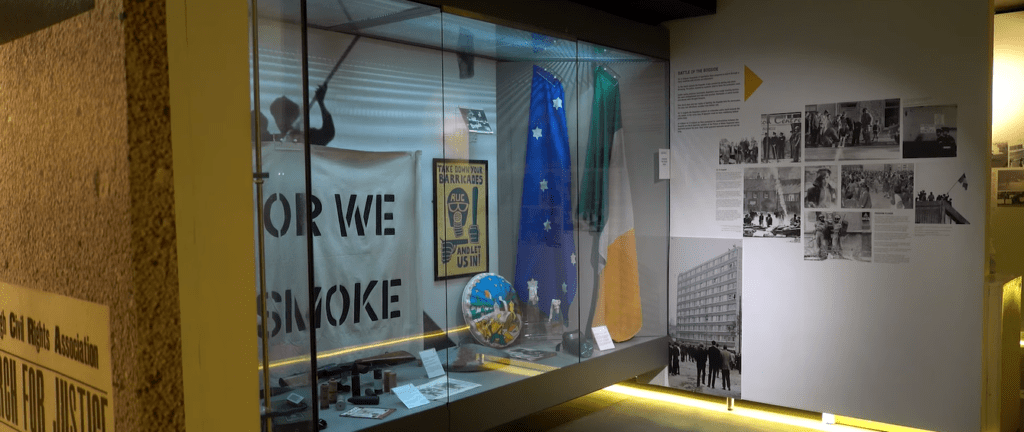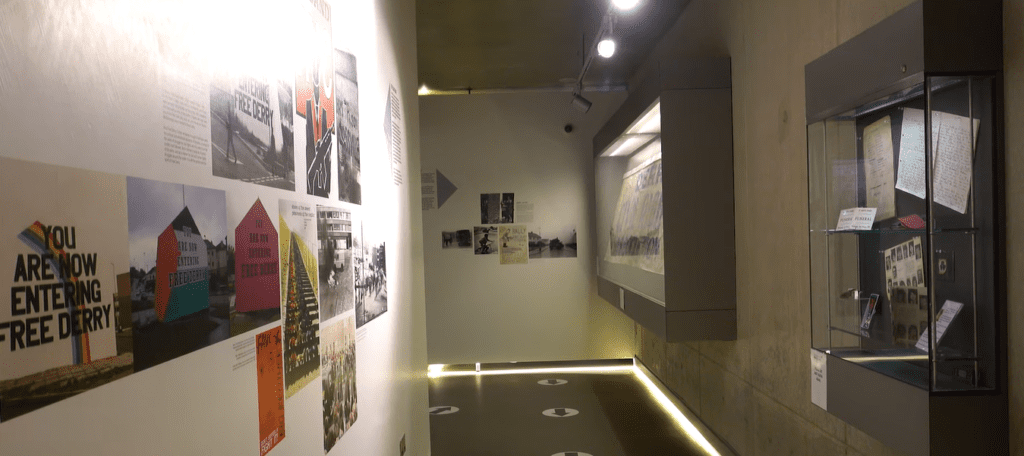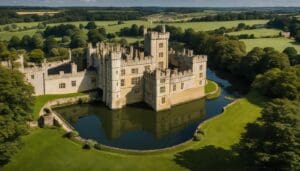Museum Of Free Derry | Londonderry | Derry, Northern Ireland

Updated On: April 15, 2024 by Ahmed Samir
An idyllic destination for everyone, Derry, Northern Ireland, offers inspiring experiences and adventures, making easy for visitors to enjoy their time. We’ll now take you to the Museum Of Free Derry, one of the city’s outstanding museums.
In the heart of Northern Ireland, the Museum of Free Derry is a testament to the indomitable spirit of a city that has weathered the storms of history. Situated in Derry, also known as Londonderry, this museum is a repository of artefacts and stories and a living chronicle of a community’s struggle for justice, civil rights, and reconciliation amidst the Troubles.
This comprehensive article takes you on a journey through the Museum of Free Derry, delving deep into its historical significance, captivating exhibits, and pivotal role in the ongoing healing process in Northern Ireland. As we explore the museum’s corridors, we will discover the powerful narratives that have shaped Derry and, by extension, the entire region.
Derry: A City of Centuries-Old Significance
Before delving into the Museum Of Free Derry itself, it is essential to understand the historical context in which the Museum of Free Derry exists. Derry, or Londonderry, is the second-largest city in Northern Ireland and is prominent in history. The city’s name is a point of contention, reflecting the historical and political divisions that have defined the region for centuries.
Derry’s history is marked by its strategic location on the River Foyle, making it a hub for trade and commerce. Throughout its history, the city has witnessed waves of conflict, starting with the early 17th-century plantation of Ulster by English and Scottish settlers. The city’s walls, which still stand today, were constructed during this period to protect the immigrants from indigenous Irish inhabitants.
A Period of Conflict and Struggle
In the latter half of the 20th century, Derry became a focal point of a much darker chapter in Northern Ireland’s history—the Troubles. This period, roughly from the late 1960s to the Good Friday Agreement of 1998, was marked by sectarian violence, political conflict, and civil unrest. Derry, in particular, experienced some of the worst violence and bloodshed of the Troubles.
One of the most infamous events in Derry’s history is the Bloody Sunday massacre of 30 January 1972, when British soldiers opened fire on a civil rights march, killing 14 unarmed civilians. This event was a catalyst for increased violence and polarization in the region, further deepening the divide between communities.
The Birth of the Museum of Free Derry
The Museum of Free Derry was established to commemorate the events of Bloody Sunday and the broader struggle for civil rights and justice in Derry during the Troubles. It is located in the heart of the Bogside area, which was a focal point for civil rights activism and resistance during this tumultuous period.
The museum’s name, “Free Derry,” is derived from the slogan “You are now entering Free Derry,” which was proclaimed by residents who barricaded the Bogside neighbourhood and declared it a “Free” or liberated area during the Troubles. This slogan and its defiant spirit became symbols of resistance and solidarity.
The museum officially opened its doors in 2007. Since then, it has become a vital institution for preserving and sharing the history of the Troubles and the struggle for justice in Northern Ireland. The museum’s mission is not just to recount the past but to engage visitors in a critical reflection on the Troubles and their impact on the community.
Exhibits and Collections

The Museum of Free Derry boasts an impressive collection of artefacts, documents, and multimedia presentations that tell the story of the Troubles from the perspective of the local community. The exhibits are thoughtfully curated, providing visitors with a comprehensive and emotionally impactful experience.
- The Bloody Sunday Gallery: Central to the museum’s mission, it chronicles the events leading up to Bloody Sunday, the day itself, and its aftermath. It features photographs, eyewitness testimonies, and a replica of the “Rossville Flats” barricade, where some of the victims were shot. Visitors can gain a deep understanding of the tragedy and its profound impact on Derry.
- Civil Rights: This exhibit explores the civil rights movement in Northern Ireland and the specific demands and actions taken by activists in Derry. It delves into the struggles for fair housing, voting rights, and an end to discrimination, providing valuable context for understanding the broader conflict.
- The Battle of the Bogside: Focusing on the tumultuous events of August 1969, when the Bogside erupted in violence, this exhibit explores the community’s resistance to police and military incursions. It features artefacts from the battle, including gas masks and barricade materials.
- The Role of Women: The museum recognizes women’s essential role in the struggle for justice and equality during the Troubles. This exhibit highlights the contributions of female activists and their experiences.
- Political Prisoners: The Troubles saw many individuals imprisoned for their political activities. This exhibit sheds light on the experiences of these prisoners and their families, featuring personal accounts and artefacts from H-Block and Armagh Gaols.
- Legacy and Reconciliation: The museum also focuses on the gift of the Troubles and the ongoing reconciliation process in Northern Ireland. It encourages visitors to consider the lessons that can be learned from this troubled historical period.
Impact and Educational Outreach
The Museum of Free Derry is not merely a static repository of history; it actively engages with the community and promotes education, dialogue, and reflection. Its impact extends far beyond its walls through various educational programs and initiatives.
- School Programs: The museum hosts educational programs for schools to give students a deeper understanding of the Troubles and their consequences. These programs encourage critical thinking and empathy.
- Community Engagement: The museum collaborates with local communities to ensure that the history of the Troubles is preserved and shared accurately. It actively seeks out the stories and perspectives of those directly affected by the conflict.
- Public Events: The museum organizes public events, lectures, and exhibitions that address contemporary social and political issues, fostering dialogue and reconciliation.
- Research and Archives: The museum’s extensive archives are a valuable resource for researchers and scholars studying the history of Northern Ireland. It provides access to primary sources and materials related to the Troubles.
- International Visitors: The museum welcomes visitors worldwide, offering guided tours and opportunities for international dialogue on conflict resolution and peacebuilding issues.
The Significance of the Museum

The Museum of Free Derry holds immense significance on multiple levels:
- Commemoration: It serves as a place of remembrance for those who lost their lives during the Troubles, ensuring that their stories are not forgotten.
- Education: The museum plays a crucial role in educating locals and visitors about the history of the Troubles, fostering a deeper understanding of the conflict and its complex legacy.
- Reconciliation: By addressing the legacy of the Troubles and promoting dialogue, the museum contributes to the ongoing reconciliation process in Northern Ireland.
- Empowerment: The museum empowers the community by giving a voice to those who lived through the Troubles and encouraging them to share their experiences.
- International Perspective: It offers an opportunity for international visitors to learn about the conflict and consider its relevance to broader global issues of conflict resolution and peacebuilding.
Conclusion
The Museum of Free Derry in Londonderry, Northern Ireland, is more than just a historical institution; it is a living testament to the human capacity for endurance, reconciliation, and hope. As we’ve journeyed through its exhibits and explored the tumultuous history of Derry, it becomes abundantly clear that this museum plays a pivotal role in preserving the memory of a community that faced the darkest times during the Troubles. Its dedication to accurately narrating the past, empowering the present, and inspiring a better future inspires the people of Northern Ireland and the world.
The Museum of Free Derry is a potent reminder that despite conflict and adversity, there is a resilient spirit that seeks understanding, healing, and unity. Its mission to educate, engage, and promote reconciliation is a beacon of hope in a world where such values are often in short supply. As we leave this institution, we carry with us not only the stories of Derry but also a profound sense of the enduring human spirit and the belief that, through dialogue and understanding, we can strive for a world where peace triumphs over division.
FAQs
How does the museum impact the community and promote reconciliation?
The Museum of Free Derry engages with schools, communities, and the public through educational programs, events, and dialogue. It actively seeks to reconcile differences and promote understanding.
What lessons can be learned from the Museum of Free Derry’s mission and exhibits?
The museum encourages critical thinking about the Troubles, the consequences of conflict, and the importance of reconciliation and peacebuilding, providing valuable lessons for visitors.
What overarching message does the Museum of Free Derry convey to the world?
The museum serves as a symbol of hope, resilience, and the enduring human spirit. It underscores the importance of remembrance, empathy, and the pursuit of peace, even in the face of the darkest times in history.






